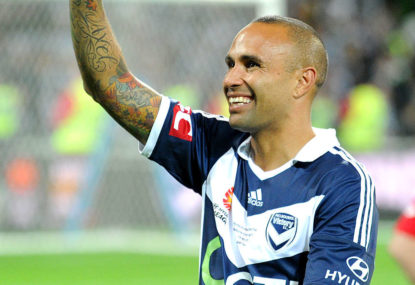Controversy as Villa keeper handed second yellow for shootout crowd taunting... but isn't sent off
Emi Martinez was saved by a new rule that resets yellow cards at the end of extra time, meaning his second yellow for taunting…

There has been an interesting flurry of activity in the media concerning football recently.
Overshadowing the FFA Cup Round-of-32 results was an intriguing back-and-forth media releases between the Professional Footballers Association (PFA) and Football Federation Australia (FFA).
Putting aside the issues this raises about the FFA’s relationship with the game’s stakeholders, it will undoubtedly raise the issue of the salary cap once again.
Firstly, it is important to point out the lessons from the English Premier League. England’s top tier has seen a broadcast revenue driven exponential rise in the past two decades following the introduction of the Premier League model.
It is highly debatable as to whether this revenue has trickled down into the English football economy. There has been investment in top level stadiums, but it can be argued this relates as much to product presentation and season ticket revenue generation as it does the benefit of the English football fraternity.
Outside of that, the extra money has gone into the substantial inflation of player wages. Despite there being more money flowing through the top tier of the English game, the financial instability of clubs has increased and many have faced near liquidation.
This then brings us to the local sporting scene. Recently the substantial rises in AFL broadcast revenue has seen a sharp rise in AFL player wages.
This comes on the back of a push for a rise on player wages as they came towards the end of the previous broadcast rights deal. One line in particular stands out: “The AFLPA is also considering the American model of pegging the salary cap to the total revenue of the sport, a system that has been used by the National Football League in the United States”.
This bears an intriguing resemblance to what the purported stumbling block appears to be if we look back just over a month to comments attributed to Damien de Bohun – “Instead, the PFA wants 30 per cent of all game revenues…That’s economic madness. FFA and the clubs will not entertain a proposal that would cripple the A-League”.
Naturally there is a lot of conjecture as to what is really happening and so this author won’t jump to conclusions.
Instead I will affirm my belief that the best mix is one where we have a fixed cap allowing for a living wage as it is now, and adjusted for inflation. This cap for each team should quite simply be fully subsidised by broadcast revenue specifically.
The larger teams can naturally elicit comparative advantage from membership and sponsor revenue through taking advantage of marquee provisions as is effectively the case now if they so choose.
It is hardly surprising as a phenomenon that the players are going to want a larger share as revenue rises substantially, but it needs to be affirmed that it is important more than ever to maintain the basic structure of the cap as it has existed up until now to keep operating costs down.
In essence the talent pool within Australia will remain effectively unchanged as many players of note tend to get poached either by European or Asian teams. The football fraternity will be paying higher wages for a similar level of talent.
The international nature of football means that player wage inflation for A-League level talent can in effect be “outsourced” to overseas countries – particularly Asia – which has been the case thus far so this relationship goes two ways and isn’t without its benefits for the Australian football fraternity.
The main priority for surplus income is for it to be invested in building physical infrastructure owned by the football fraternity.
This will be of vital importance in reinforcing the economics of running a professional level football competition in Australia as it can help alleviate the substantial costs in leasing or sub-leasing council of state government-owned facilities.
A perfect example is the very recent criticism of Brisbane Roar owners the Bakrie Group by Queensland Rugby Union officials over unpaid usage of Ballymore.
If increased revenue simply goes into inflating player wages and hence the operating costs of A-League teams even further, it not only acts as a further disincentive for private investors to get involved. It bloats the complexity of the A-League and makes it less flexible in being able to face economic downturns and changes in the broadcasting business models.
From this perspective, while it may be considered behind the AFL and NRL in terms of size and revenue growth, there is a leanness to the A-League in that it is the sport the least bloated by complexity.
This can be of great strength in certain circumstances as football is the most adaptable to a changing economic paradigm, for example in TV broadcast industry as smaller online oriented players move into the market.
Key to maintaining this is to keep a lid on operating costs. This involves maintaining the A-League as an eight-to-ten team competition for the foreseeable future and focusing on developing the FFA Cup as a dual competition.
Importantly, however, it means keeping a lid on a rise in the costs of accommodating player wages.